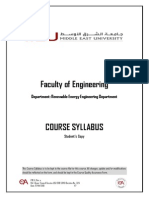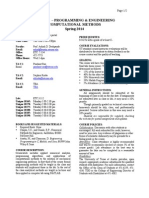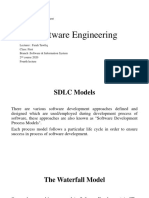Math315Syllabus
Uploaded by
zihanliangeddieMath315Syllabus
Uploaded by
zihanliangeddieMath 315-2: Numerical Analysis
Fall 2024
MSC W303, TTh 1:00-2:15
MSC W303, Fr 11:30-12:20
Instructors: Prof. Talea L. Mayo
MSC E426
talea.mayo@emory.edu
Prof. Ansley Bentley
ansley.bentley@emory.edu
Notable dates and times:
Lecture: TTh, 1:00 pm – 2:15 pm
Lab: F, 11:30 pm – 12:20 pm
Midterm Exam 1: Th, October 3 (tentative)
Midterm Exam 2: Th, November 14 (tentative)
Final Exam: T, May 2, 11:30 am – 2:00 pm
Course aims: This course provides an introduction to scientific computation,
including understanding how some of the best numerical
software works, and how to use computational tools to solve
realistic problems in science and engineering applications.
Required software: MATLAB
In preparation for this course, you should set up and familiarize
yourself with the software package MATLAB. I’d like you to do
all computing assignments using MATLAB. To download, first
create an account at https://www.mathworks.com/account
using your Emory email.
Textbook: Introduction to Scientific Computing using Matlab, by I.
Gladwell, J. G. Nagy and W. E. Ferguson, Jr.
(text will be made available through Canvas)
Additional resources:
• A First Course in Numerical Methods, U. Ascher and C.
Greif, SIAM, 2011
• Numerical Mathematics, A. Quarteroni, Riccardo Sacco,
and F. Saleri, Springer, 2006
(The Woodruff Library has an electronic subscription for SIAM
(Society of Industrial and Applied Mathematics) publications,
so you have access to copies of all SIAM published books.)
Prerequisites: You should have a working knowledge or the basics of linear
algebra (Math 221/275/321), calculus (Math 111 and
112/112Z), and programming (CS 170).
Course Format:
Lecture: Each class will consist of interactive lectures. These might
include presentation of new material, example applications,
MATLAB demonstrations, more detailed explanations, etc.
Attendance is not officially required, however I believe you will
greatly benefit from in class participation. It is unofficially
requested, i.e. I’d like you to regularly attend the synchronous
sessions.
Each week you may wish to review material from the course
textbook, which will include both explanations on theoretical
topics and MATLAB implementations. If needed, I am also
happy to direct you to other material to help supplement the
text.
Lab Sessions: Lab sessions will be lead by our teaching assistant, Prof.
Ansley Bentley, and held each Friday, excluding week 0 and
exam weeks (weeks 5 and 11). You will complete assigned
exercises in class, and these will be graded for accuracy and/or
completion. Additionally, if you have questions about the
weekly homework assignments (also due Fridays), the lab
session provides an excellent opportunity to get assistance.
Weekly Problem Sets: Problem Sets will be assigned each week and will generally
include a mix of numerical analysis and implementation in
MATLAB. You will work on these assignments, individually or
in randomly assigned teams of 2-3. This will be specified with
the assignment but generally alternates by week. For group
work, each team should develop one submission, which might
include solutions to math problems, MATLAB code, results rom
MATLAB experiments, plots, etc. A single PDF document for
each group should be uploaded to Canvas. This PDF should be
typeset using LaTeX (it is often appropriate to embed scratch
work/hand calculations as an image). Homework will be graded
for completion, accuracy, and/or clarity of presentation.
There will be 11 homework assignments (due every Friday
beginning September 6th, excluding exam weeks). There will be
no makeup opportunities for homework assignments, but your
lowest score will be dropped when computing your
final grade.
Exams: There will be two midterm exams, tentatively given on
Thursday, October 3 and Thursday, November 14. The
(cumulative) final exam will be given on Thursday, December
12, 11:30 am – 2:00 pm. Requests for makeups of the midterm
and final exams are discouraged and will only be granted under
reasonable circumstances. Requests should be made as soon
as possible and in advance of the exam, where possible.
Justification should be verified by the Office of Undergraduate
Education (OUE).
Grading: Your final grade for the course will be determined as follows:
Final Exam, Problem
30% Sets, 25%
Lab Work,
Midterm 2, 15%
15%
Midterm 1,
15%
The final course grades will be distributed as:
Teaching and Learning During Local and Broader challenges:
This semester is (unfortunately not so) unusual in that there is
(still) a global pandemic (among a lot of other national and
world chaos). As always, open communication will be
especially important. I commit to responding to emails within
24 business hours of receipt. If your personal circumstances
change, i.e. regarding health, housing, or any other aspect of
your ability to actively participate in the class, please contact
the appropriate Emory student support organization first and
then me as soon as feasible. I want to emphasize that my
primary goal is to help you succeed academically and
holistically.
Academic Integrity: By participating in this course, you are accepting the Emory
Honor Code. See https://catalog.college.emory.edu/policies/
honor-code.html. I am obligated to report academic
misconduct, so please engage in this course ethically so I don’t
have to!
Student Accessibility: Emory is committed advancing an accessible and barrier-
free environment for students by ensuring that the principles
of access, equity, inclusion, and learning are realized in and by
the Emory community. Please assist me in accommodating you
by registering with the Department of Accessibility Services.
See https://accessibility.emory.edu. I also encourage you to
schedule an appointment with me to discuss any additional
accommodations I can make to best support your learning!
Diversity and Inclusion: Emory University strives to provide a welcoming, diverse, and
inclusive campus as an essential part of a community of
academic excellence. Dimensions of diversity include sex, race,
age, national origin, ethnicity, gender identity and expression,
intellectual and physical ability, sexual orientation, income,
faith and non-faith perspectives, socio-economic class, political
ideology, education, primary language, family status, military
experience, cognitive style, and communication style. Please
make a personal effort to respect and include all members of
our community, especially in this class. See
https://www.emory.edu/home/explore/life/diversity-
inclusion.html for more information and resources.
I am very much looking forward to teaching you numerical analysis this semester!
You might also like
- Parzen Stat104 Syllabus FALL 2017V6 Campus V4 PDFNo ratings yetParzen Stat104 Syllabus FALL 2017V6 Campus V4 PDF8 pages
- IBIO 2240 PROGRAMACIÓN CIENTÍFICA-201510-Prof. J Son PDFNo ratings yetIBIO 2240 PROGRAMACIÓN CIENTÍFICA-201510-Prof. J Son PDF3 pages
- MATH 368K (54195) : Numerical Methods For Applications: General InformationNo ratings yetMATH 368K (54195) : Numerical Methods For Applications: General Information4 pages
- Math 0290: Differential Equations, Fall 2017 Departmental Syllabus - M. Lewicka Section - MWF 11:00am, G31 Benedum HallNo ratings yetMath 0290: Differential Equations, Fall 2017 Departmental Syllabus - M. Lewicka Section - MWF 11:00am, G31 Benedum Hall2 pages
- Numerical Methods For Engineers With PerNo ratings yetNumerical Methods For Engineers With Per5 pages
- UT Dallas Syllabus For cs4334.501 06f Taught by Bentley Garrett (btg032000)No ratings yetUT Dallas Syllabus For cs4334.501 06f Taught by Bentley Garrett (btg032000)7 pages
- Math 171 Course Guide - 2ndsem22-23 - MendozaVMPNo ratings yetMath 171 Course Guide - 2ndsem22-23 - MendozaVMP4 pages
- IOE 265 Probability and Statistics For Engineers - Winter 2004 Section 200No ratings yetIOE 265 Probability and Statistics For Engineers - Winter 2004 Section 2005 pages
- M 225.02 - Introduction To Discrete MathematicsNo ratings yetM 225.02 - Introduction To Discrete Mathematics3 pages
- Math 411-Course Syllabus-Winter2211 (Term2)No ratings yetMath 411-Course Syllabus-Winter2211 (Term2)5 pages
- Course Section Information Information and Communications TechnologyNo ratings yetCourse Section Information Information and Communications Technology4 pages
- Advanced Engineering Mathematics SyllabusNo ratings yetAdvanced Engineering Mathematics Syllabus7 pages
- Analytic Geometry Calculus 1 With MATLAB - C2No ratings yetAnalytic Geometry Calculus 1 With MATLAB - C212 pages
- Me 318M - Programming & Engineering Computational Methods Spring 2014No ratings yetMe 318M - Programming & Engineering Computational Methods Spring 20142 pages
- ECE 4213/5213 Digital Signal Processing Fall 2018No ratings yetECE 4213/5213 Digital Signal Processing Fall 20184 pages
- National Grade Six Assessment Social Studies P1No ratings yetNational Grade Six Assessment Social Studies P117 pages
- Introduction To Oracle Linux - Shell and Command LineNo ratings yetIntroduction To Oracle Linux - Shell and Command Line1 page
- TIH 100M_230V - Extra large induction heaters _ SKFNo ratings yetTIH 100M_230V - Extra large induction heaters _ SKF5 pages
- Sleeve Springs: Diesel Customer Information No. 291No ratings yetSleeve Springs: Diesel Customer Information No. 2912 pages
- Ciara Della-Flora SHE (Technology's Influence On Psychological Mental Health)No ratings yetCiara Della-Flora SHE (Technology's Influence On Psychological Mental Health)3 pages
- LESSON-3 History of Global Politics Creating An International Order100% (1)LESSON-3 History of Global Politics Creating An International Order40 pages
- ISO 15189 Accreditation: Benita I.Haines Corporate Compliance and Quality Manager For Valley Health July 19, 2009No ratings yetISO 15189 Accreditation: Benita I.Haines Corporate Compliance and Quality Manager For Valley Health July 19, 200915 pages
- 14 - Fly Guy's Big Family _ Book Study ActivitiesNo ratings yet14 - Fly Guy's Big Family _ Book Study Activities62 pages
- Placement Project BMIH6006.8 - Autumn Term 2023 Handbook FINAL KF EE PDFNo ratings yetPlacement Project BMIH6006.8 - Autumn Term 2023 Handbook FINAL KF EE PDF20 pages
- 4.5 - Datex Ohmeda Aestiva 5 Brochure and Specs PDFNo ratings yet4.5 - Datex Ohmeda Aestiva 5 Brochure and Specs PDF1 page
- Physics Lesson Notes On Heat Capacity and Specific Heat CapacityNo ratings yetPhysics Lesson Notes On Heat Capacity and Specific Heat Capacity5 pages
- كتاب أساسيات جودة الرعاية الصحية و أمان المريض المعهد 1100% (1)كتاب أساسيات جودة الرعاية الصحية و أمان المريض المعهد 1133 pages
- Siwes Report (Ime Industrial Maintenance Engineering) - 063225No ratings yetSiwes Report (Ime Industrial Maintenance Engineering) - 06322520 pages
- SDET Bottles Filling and Capping Machine Operation ManualNo ratings yetSDET Bottles Filling and Capping Machine Operation Manual10 pages
- Software Engineering: University of Technology Computer Science DepartmentNo ratings yetSoftware Engineering: University of Technology Computer Science Department13 pages
- IBIO 2240 PROGRAMACIÓN CIENTÍFICA-201510-Prof. J Son PDFIBIO 2240 PROGRAMACIÓN CIENTÍFICA-201510-Prof. J Son PDF
- MATH 368K (54195) : Numerical Methods For Applications: General InformationMATH 368K (54195) : Numerical Methods For Applications: General Information
- Math 0290: Differential Equations, Fall 2017 Departmental Syllabus - M. Lewicka Section - MWF 11:00am, G31 Benedum HallMath 0290: Differential Equations, Fall 2017 Departmental Syllabus - M. Lewicka Section - MWF 11:00am, G31 Benedum Hall
- UT Dallas Syllabus For cs4334.501 06f Taught by Bentley Garrett (btg032000)UT Dallas Syllabus For cs4334.501 06f Taught by Bentley Garrett (btg032000)
- IOE 265 Probability and Statistics For Engineers - Winter 2004 Section 200IOE 265 Probability and Statistics For Engineers - Winter 2004 Section 200
- Course Section Information Information and Communications TechnologyCourse Section Information Information and Communications Technology
- Me 318M - Programming & Engineering Computational Methods Spring 2014Me 318M - Programming & Engineering Computational Methods Spring 2014
- Introduction To Oracle Linux - Shell and Command LineIntroduction To Oracle Linux - Shell and Command Line
- TIH 100M_230V - Extra large induction heaters _ SKFTIH 100M_230V - Extra large induction heaters _ SKF
- Sleeve Springs: Diesel Customer Information No. 291Sleeve Springs: Diesel Customer Information No. 291
- Ciara Della-Flora SHE (Technology's Influence On Psychological Mental Health)Ciara Della-Flora SHE (Technology's Influence On Psychological Mental Health)
- LESSON-3 History of Global Politics Creating An International OrderLESSON-3 History of Global Politics Creating An International Order
- ISO 15189 Accreditation: Benita I.Haines Corporate Compliance and Quality Manager For Valley Health July 19, 2009ISO 15189 Accreditation: Benita I.Haines Corporate Compliance and Quality Manager For Valley Health July 19, 2009
- Placement Project BMIH6006.8 - Autumn Term 2023 Handbook FINAL KF EE PDFPlacement Project BMIH6006.8 - Autumn Term 2023 Handbook FINAL KF EE PDF
- 4.5 - Datex Ohmeda Aestiva 5 Brochure and Specs PDF4.5 - Datex Ohmeda Aestiva 5 Brochure and Specs PDF
- Physics Lesson Notes On Heat Capacity and Specific Heat CapacityPhysics Lesson Notes On Heat Capacity and Specific Heat Capacity
- كتاب أساسيات جودة الرعاية الصحية و أمان المريض المعهد 1كتاب أساسيات جودة الرعاية الصحية و أمان المريض المعهد 1
- Siwes Report (Ime Industrial Maintenance Engineering) - 063225Siwes Report (Ime Industrial Maintenance Engineering) - 063225
- SDET Bottles Filling and Capping Machine Operation ManualSDET Bottles Filling and Capping Machine Operation Manual
- Software Engineering: University of Technology Computer Science DepartmentSoftware Engineering: University of Technology Computer Science Department

























































































